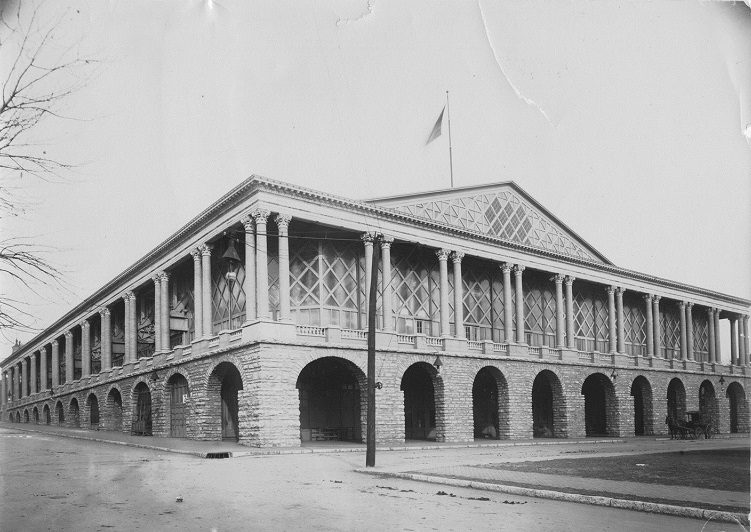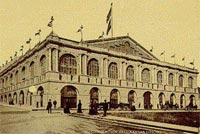In the 1890s the Kansas City Star campaigned vigorously for the construction of an impressive convention hall that could draw important political events, business conferences, or entertainment to the vibrant city. A large new building would surpass several smaller opera houses that hosted the cultural events of the city. On February 22, 1899, a group of Kansas City businessmen fulfilled the newspaper's vision by opening Convention Hall at 13th and Central Street, built at the cost of $225,000.
Convention Hall opened with a performance by John Philip Sousa's band in front of a then-impressive crowd of 20,000. Subsequent performances that year included Polish pianist Ignace Jan Paderewski and evangelist Dwight Moody. Moody's visit turned tragic when he collapsed while giving a sermon in Convention Hall. He died a month later.
Convention Hall was clearly serving its purpose by bringing in notable guests, but the biggest event planned was the July 1900 Democratic National Convention. This would probably be the most important political event in Kansas City's history.
Then, three months before the convention was scheduled to begin, disaster struck. Convention Hall, which was just over a year old, caught fire on April 4, 1900, and burned to the ground before firefighters could save it. Only some of the exterior stone walls remained intact.
Urged by Mayor James A. Reed and a public outpouring of support, the Convention Hall managers rapidly raised enough funds to construct a new building by holding public fundraising campaigns and using the insurance claim money. It had taken two years to acquire funding and construct the original building, so rebuilding in just 90 days for the Democratic National Convention would be an impressive feat.
Local construction companies temporarily set aside labor and management disagreements and worked on a second Convention Hall. Designed to similar specifications as the first building, it was miraculously completed just in time for the Democratic National Convention, where the party nominated William Jennings Bryan to the second of his three unsuccessful candidacies for president of the United States. The rebuilding achievement added to the city's existing reputation for an impressive public spirit and unwavering business leadership that had characterized it since its earliest years.
The second Convention Hall lasted much longer than the first and served as a mainstay for some of Kansas City's biggest events, including the Republican National Convention in 1928 that nominated Herbert Hoover to run for President. Finally, after the construction of the larger, more luxurious Municipal Auditorium in 1934, the city demolished Convention Hall to make way for a parking lot.
Read biographical sketches of important people in Convention Hall history, prepared by the Missouri Valley Special Collections, The Kansas City Public Library.
- Biography of James Alexander Reed (1861-1944), Attorney and Politician; Kansas City mayor who helped prompt the rebuilding of Convention Hall, by Nancy J. Hulston, 1999
- Biography of Uriah Epperson (1861-1927) and Mary E. Epperson (1855-1939), Philanthropists; helped construct the first Convention Hall, by Daniel Coleman, 2008
- Biography of Edward Harry Kelly (1879-1955), Composer, Band and Orchestra leader; played at Convention Hall, by Dory DeAngelo, 1999
- Biography of Lucy Drage (1876-1965), Interior Decorator; named the “Belle” of the Century Ball held at Convention Hall, December 31, 1900, by Daniel Coleman, 2008
- Biography of Thomas C. Unthank (1866-1932), Black Physician; treated victims of the 1903 flood in a makeshift hospital at Convention Hall, by Nancy J. Hulston, 1999
View images of Convention Hall that are a part of the Missouri Valley Special Collections.
- Construction of Convention Hall; not known whether it is the first or second building
- Postcard of Kansas City's Convention Hall
- Postcard of Kansas City's Convention Hall, with elephant
- Crowd Scene Viewing Aftermath of Fire Which Destroyed First Building, 1900
- Interior View of First Building After Fire, 1900
- Construction View of Second Building, with rubble in foreground, 1900
- Second Convention Hall, exterior view, 1900
- 1900 Preparations for Democratic National Convention, Interior View
- 1900 Democratic National Convention in Session, Interior View
- Exterior View of Convention Hall at the 1928 Republican National Convention
- Convention Hall Staff, 1928
Check out the book, Kansas City Style: A Social and Cultural History of Kansas City as Seen Through its Lost Architecture, by Dory DeAngelo and Jane Fifield Flynn; contains brief profiles of the first and second Convention Halls, with images, pp. 54-57.
Continue researching events held at Convention Hall using archival material from the Missouri Valley Special Collections.
- Vertical File: Grand Century Ball
- Vertical File: Democratic Party--National Convention 1900
- Vertical File: Convention Hall
- Vertical File: Kansas City Woman's Exposition
- Vertical File: Memorial Day Events
- Vertical File: Republican National Convention, 1928
- Vertical File: Revivals, Dwight Moody
- Rebuilding Convention Hall: An Episode in the Life of a City, by Edwin H. White
References:
Brown, A. Theodore and Lyle W. Dorsett. K.C.: A History of Kansas City, Missouri. Boulder, CO: Pruett Pub, 1978.
DeAngelo, Dory. What About Kansas City!: A Historical Handbook. Kansas City, MO: Two Lane Press, 1995.
DeAngelo, Dory and Jane Fifield Flynn. Kansas City Style: A Social and Cultural History of Kansas City as Seen Through its Lost Architecture. Kansas City, MO: Harrow Books, 1990.
Ford, Susan Jezak. Municipal Auditorium Profile. Missouri Valley Special Collections, 1999.
Green, George Fuller. A Condensed History of the Kansas City Area: Its Mayors and Some V.I.P.s. Kansas City, MO: The Lowell Press, 1968.
Haskell, Henry C. City of the Future: A Narrative History of Kansas City, 1850-1950. Kansas City, MO: F. Glenn, 1950.



